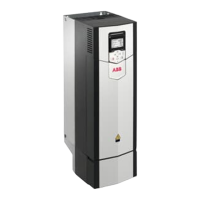Def / Type
FbEq 16b / 32b
DescriptionName / Range /
Selection
No.
3Standstill ID run. The motor is injected with DC current.
With an AC induction (asynchronous) motor, the motor
shaft is not rotated. With a permanent magnet motor
or synchronous reluctance motor, the shaft can rotate
up to half a revolution.
Note: A standstill ID run should be selected only if the
Normal, Reduced or Advanced ID run is not possible
because of the restrictions caused by the connected
mechanics (e.g. with lift or crane applications.
See also selection Advanced Standstill.
Standstill
4The autophasing routine determines the start angle of
a permanent magnet or synchronous reluctance motor
(see section Autophasing (page 89)). Autophasing does
not update the other motor model values.
Autophasing is automatically performed as part of the
Normal, Reduced, Standstill, Advanced or Advanced
Standstill ID runs. Using this setting, it is possible to
perform autophasing alone. This is useful after changes
in the feedback configuration, such as the replacement
or addition of an absolute encoder, resolver, or pulse
encoder with commutation signals.
Note: This setting can only be used after a Normal,
Reduced, Standstill, Advanced or Advanced Standstill
ID run has already been performed.
Note: Depending on the selected autophasing mode,
the shaft can rotate during autophasing. See parameter
21.13 Autophasing mode.
Autophasing
5Requests current measurement calibration, i.e.
identification of current measurement offset and gain
errors.
The calibration will be performed at next start.
Current
measurement
calibration
6Advanced ID run. Guarantees the best possible control
accuracy. The ID run can take a couple of minutes. This
mode should be selected when top performance is
needed across the whole operating area.
Note: If the load torque is higher than 20% of motor
nominal torque, or if the machinery is not able to
withstand the nominal torque transient during the ID
run, then the driven machinery must be de-coupled
from the motor during a Advanced ID run.
Note: Check the direction of rotation of the motor
before starting the ID run. During the run, the motor
will rotate in the forward direction.
WARNING! The motor will run at up to
approximately 50…100% of the nominal speed
during the ID run. Several accelerations and
decelerations are done. MAKE SURE THAT IT IS
SAFE TO RUN THE MOTOR BEFORE
PERFORMING THE ID RUN!
Advanced
Parameters 541

